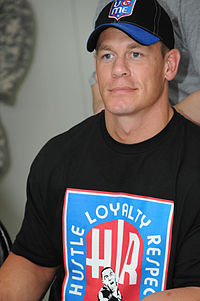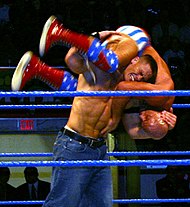John Cena

Billed height : 6 ft 1 in (1.85 m)
Billed weight : 240 lb (110 kg)
Born : April 23, 1977 (1977-04-23) (age 33) West Newbury, Massachusetts
Resides : Tampa, Florida
Billed from : Classified (UPW)
West Newbury, Massachusetts (WWE)
Trained by;
Ultimate Pro Wrestling, Ohio Valley Wrestling
Debut : 2001
John Felix Anthony Cena, is an American actor, rapper, and professional wrestler employed by World Wrestling Entertainment (WWE) on its Raw brand.
In WWE, Cena has won fifteen championships in total, including nine World Titles (having won the WWE Championship seven times and the World Heavyweight Championship twice). In addition, Cena has also won the WWE United States Championship three times, the World Tag Team Championship twice (once with Shawn Michaels, once with Batista), and the WWE Tag Team Championship once (with David Otunga). Cena also won the 2008 Royal Rumble match, and the 2009 Superstar of the Year Slammy Award.
Cena started his professional wrestling career in 2000, wrestling for Ultimate Pro Wrestling, where he held the UPW Heavyweight Championship. In 2001, Cena signed a contract with the World Wrestling Federation (WWF) and was sent to Ohio Valley Wrestling (OVW) where he held the OVW Heavyweight Championship and the OVW Southern Tag Team Championship (with Rico Constantino).
Outside of wrestling, Cena has released the rap album You Can't See Me, which debuted at #15 on the US Billboard 200 chart, and starred in the feature films The Marine (2006), 12 Rounds (2009), and Legendary (2010). Cena has also made appearances on television shows including Manhunt, Deal or No Deal, MADtv, Saturday Night Live, Punk'd, and Psych. Cena was also a contestant on Fast Cars and Superstars: The Gillette Young Guns Celebrity Race, where he made it to the final round before being eliminated, placing third in the overall competition.
Early life
Cena was born April 23, 1977, in West Newbury, Massachusetts, the son of Carol and John Cena, Sr.He is the second eldest of five brothers – Dan, Matt, Steve, and Sean. After graduating from Cushing Academy, Cena attended Springfield College in Springfield, Massachusetts. In college he was a Division III All-American center on the college football team, wearing the number 54, which is still used on some of his WWE merchandise. He graduated from Springfield in 1998 with a degree in exercise physiology, after which he pursued a career bodybuilding,and also worked as a chauffeur for a limousine company.
Professional wrestling career
Training
Cena started training to become a professional wrestler in 2000 at the California-based "Ultimate University" operated by Ultimate Pro Wrestling. Once he was placed into an in-ring role, Cena began using a semi-robotic character known as The Prototype.Some of this period of his career was documented in the Discovery Channel program Inside Pro Wrestling School. While in UPW, Cena held the UPW Heavyweight Championship for just shy of a month in April 2000.In 2001, he signed a developmental contract with the World Wrestling Federation (WWF) and was assigned to its developmental territory Ohio Valley Wrestling (OVW). During his time there, Cena wrestled as both The Prototype and Mr. P, and held the OVW Heavyweight Championship for three months and the OVW Southern Tag Team Championship (with Rico Constantino) for two months.
World Wrestling Entertainment (2002–present)
Debut (2002–2003)

Cena performing an FU (now "Attitude Adjustment") to Kurt Angle.
Cena made his television debut answering an open challenge by Kurt Angle on June 27, 2002. Inspired by a speech given by WWE Chairman Vince McMahon to the rising stars of the company, exhorting them to show "ruthless aggression" to earn a place among the legends, Cena took advantage of the opportunity and almost beat Angle kicking out of his finishing move, the Angle Slam and enduring the ankle lock submission hold. Cena ultimately lost to a hard amateur wrestling-style pin.Following the near-win, Cena became a fan favorite and started feuding with Chris Jericho. In October, Cena and Billy Kidman took part in a tag team tournament to crown the first WWE Tag Team Champions of the SmackDown! brand, losing in the first round.The next week, Cena turned on and attacked Kidman, blaming him for their loss, becoming a villain.
Shortly after the Kidman attack, on a Halloween themed episode of SmackDown, Cena dressed as Vanilla Ice performing a freestyle rap. The next week, Cena received a new character: a rapper who cut promos while rhyming. As the gimmick grew, Cena began adopting a variant of the 1980s WWF logo — dropping the "F" — as his "signature symbol", along with the slogan "Word Life". Moreover, he was joined by an enforcer, Bull Buchanan, who was rechristened B-2 (also written B² and pronounced "B-Squared").Buchanan was later replaced by Red Dogg, until he was sent to the Raw brand in February.
For the first half of 2003, Cena sought the WWE Championship and chased the reigning champion, Brock Lesnar, performing weekly "freestyles" challenging him to matches. During the feud, Cena unveiled a new finishing maneuver: the FU, a Fireman's carry powerslam, named to mock Lesnar's F-5.Cena won a number one contenders tournament against Lesnar at Backlash. However, Cena was defeated by Lesnar. At the end of the year, Cena became a fan favorite again when he joined Kurt Angle as a member of his team at Survivor Series.
United States Champion and WWE Champion (2004–2005)